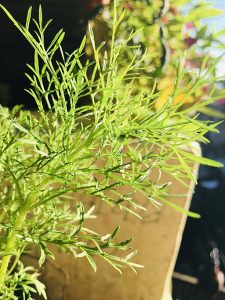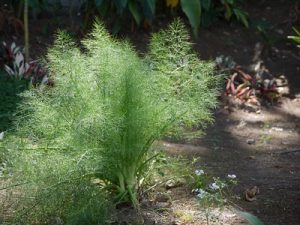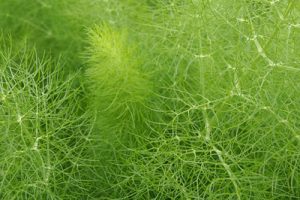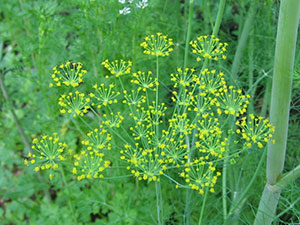Are you a fan of adding fresh, aromatic herbs to your dishes? If so, growing herbs like dill right at home could become your new favorite pastime. In this guide, we’ll explore how to cultivate dill in Central Florida, including varieties that thrive in the region, essential growing conditions, pest and disease management, and seasonality.
You might be surprised to know that dill is a member of the parsley family and originated in Asia. Now, dill is successfully grown in Florida and is common in vegetable gardens. It has a strong smell and small yellow flowers that develop into fruiting umbels.

Commonly Grown Varieties
Dill is a versatile herb known for its feathery foliage and distinct flavor. These dill varieties offer a range of flavors, sizes, and growing characteristics that make them suitable choices for gardeners in Central Florida. Dill has a presence in the kitchen and infuses dishes with vitamin A, C, calcium, and Iron.
Whether you’re a beginner or an experienced gardener, these dill varieties can add flavor and fragrance to your garden and kitchen. Here are 5 varieties that can be grown in Central Florida:
- Mammoth Dill (Anethum graveolens ‘Mammoth’):
- This variety does best in Florida. It is also a host plant of the Black Swallowtail Butterfly, a pretty pollinator with a craving for dill!
- USDA Hardiness Zone: 8-11
- Growing Conditions: Full sun, well-draining soil
- Uses: Is great for flavoring soups, stews, and sauces, as well as pickling.
- Fernleaf Dill (Anethum graveolens ‘Fernleaf’):
- USDA Hardiness Zone: 8-11
- Growing Conditions: Full sun, well-draining soil
- Uses: Ideal for container gardening, garnishing dishes, pickling, and flavoring sauces.
- Bouquet Dill (Anethum graveolens ‘Bouquet’):
- USDA Hardiness Zone: 8-11
- Growing Conditions: Full sun to partial shade, fertile soil
- Uses: Excellent for fresh use in salads, dips, seafood dishes, and for pickling cucumbers.
- Dukat Dill (Anethum graveolens ‘Dukat’):
- USDA Hardiness Zone: 8-11
- Growing Conditions: Full sun, fertile, well-drained soil
- Uses: With a more robust flavor, Dukat dill is ideal for seasoning fish, poultry, salads, and sauces.
- **Superdukat Dill (Anethum graveolens ‘Superdukat’):**
- USDA Hardiness Zone: 8-11
- Growing Conditions: Full sun, well-draining soil
- Uses: Similar to Dukat dill, Superdukat has a strong flavor profile, and is flexible with its use in the kitchen.
Growing Conditions
As we have explored, growing plants in Florida differs from growing plants in other states. Dill can thrive in Central Florida when provided with the following growing conditions.

Soil Preparation
Dill prefers well-draining soil with a pH range of 5.5 to 6.7. Incorporate organic matter (like compost) into the soil before planting. Dill likes slightly moist soil, so water consistently but allow the soil to dry between waterings to keep the roots healthy. In Central Florida, it is beneficial to grow dill in raised beds to better control moisture retention and soil texture.
You can easily and quickly (it’s very inexpensive, too!) take a soil sample using the directions and form provided by the UF/IFAS Soils Lab, where testing is available for the public. Based on the results, choose a fertilizer that caters to the specific nutritional needs of your plants. Or, if you purchase soil, check the label to see if the soil already contains fertilizers.
Go here for directions and submission details for soil tests at the UF/IFAS Soils Lab.
Sunlight
Dill will require full sun, so plant dill in a place where it can get at least 6-8 hours of sunlight daily. In Florida’s hotter months, providing partial shade during the hottest part of the day can help prevent wilting.
Read more about protecting your veggies from the cold here.
Fertilization
First things first, get your soil tested to determine which fertilizer is right for your garden. Dill has a low nutrient requirement.
Use a balanced fertilizer following the recommendations from your soil test to fertilize your plant. Apply fertilizer according to the instructions on the product label to avoid over-fertilization, which can lead to poor growth or nutrient imbalances.
Read more about fertilizers in our Fertilizer Fundamentals series:
- Fertilizer Fundamentals: How to Choose the Right One – UF/IFAS Extension Pasco County (ufl.edu)
- Fertilizer Fundamentals: How to Apply Fertilizer – UF/IFAS Extension Pasco County (ufl.edu)
- Fertilizer Fundamentals: The Best Time to Fertilize – UF/IFAS Extension Pasco County (ufl.edu)
Pest and Disease Management
Pests
While dill is relatively resistant to pests, it may occasionally attract insects such as aphids, caterpillars, and spider mites.
- Aphids: These small, soft-bodied insects can cluster on the undersides of dill leaves, sucking sap and causing damage.
- Treatment: Spray the plant with a strong jet of water to dislodge them or use Neem or insecticidal soap according to label instructions.
- Caterpillars: These insects may feed on your dill plant. Keep in mind that some caterpillars you come across in the garden are the larval stage of butterflies. If you’re planting to attract pollinators, this is great! Happy pollinator feeding time! However, if you’re planting to harvest the herbs for your own use, you can attempt to relocate the caterpillars. Butterfly larvae (caterpillars) may find their way back to the plants where you originally found them if relocated nearby, so it’s best to plant an extra plant or two just for pollinator feeding and relocation.
- Treatment: Handpick caterpillars from the plants and relocate them or dispatch them in a bucket of soapy water.
- Spider Mites: Spider mites are tiny pests that feed on plant sap, causing stippling and webbing on leaves.
- Treatment: Use insecticidal soap or oils to control spider mite populations. If needed, remove and dispose of plants with an infestation.
Diseases
Dill is susceptible to fungal diseases like powdery mildew.
- Powdery Mildew: Powdery mildew appears as a white, powdery coating on parsley leaves. It can cause leaf distortion and premature leaf drop. It is common in humid in humid conditions, so check your plant for these signs regularly.
-
- Treatment:
- Ensure proper air circulation around dill plants to reduce humidity levels.
- Apply fungicidal sprays containing sulfur or copper, and labeled for veggies, to control powdery mildew.
- Remove and dispose of infected plant parts promptly to prevent further spread.
- Treatment:
Seasonality
Dill is a hardy, cool-season annual herb that thrives in Central Florida’s mild winters and warm summers. It’s best planted by seed, September through December (although you can plant it in spring as well).
Sow dill seeds directly in the garden in the fall or early spring to take advantage of cooler temperatures. Dill can also be grown year-round in Central Florida.
Dill plants may bolt and go to seed in hot weather, signaling the end of their productive life cycle. Dill flavor is best when it starts to flower, so the best time to harvest it is as soon as you see flower buds starting to form. The stems, leaves, flowers, and seeds of the dill plant are edible.

Pruning Dill for Optimal Growth
Pruning dill helps promote bushy growth and prevents premature flowering. Let’s break down how to harvest dill:
- Identify Growth Points: Dill grows from a central stem with clusters of feathery leaves. Use clean scissors or shears to selectively remove outer stems just above the point where they emerge from the soil.
- Prune Regularly: Snip off the outermost stems as needed to promote new growth from the center of the plant. Avoid cutting more than one-third of the plant at a time. Use fresh dill leaves in cooking or store them for later use.
- Remove Flower Buds: Pinch off flower buds as soon as they appear to redirect the plant’s energy into leaf production. Allowing dill to flower and set seed will shorten its harvest window.

Dill flowers. Photo credit UF/IFAS Solutions.
Harvesting and Storage
Harvest dill leaves as needed throughout the growing season but avoid over-harvesting to allow the plant to continue producing new growth. Avoid over-harvesting to ensure the plant’s continued productivity.
Storing your clippings in a jar of water for immediate use, the water should cover the bottom of the clippings and not the leaves. For longer storage, put the jar in the refrigerator and wrap the leaves in a damp paper towel. For preservation purposes for long term, freeze or dry your clippings to make your own seasoning.

Tips for Floridian Gardeners
In Florida’s subtropical climate, dill thrives with proper care and attention:
- Select Heat-Tolerant Varieties: Choose dill varieties known for their heat tolerance, such as Bouquet or Fernleaf dill, to withstand Central Florida’s warm climate.
- Planting Considerations: Plant dill in the cooler months of fall and winter to avoid heat stress. Provide afternoon shade to protect plants from intense sunlight.
- Plant Wisely: Space dill out (about 12 inches) and consider planting your herb in a raised bed to keep the soil from becoming waterlogged in Florida’s subtropical climate. Dill can spread up to 2-3 feet, so plan ahead when you plant.
- Vigilant Pest and Disease Monitoring: Keep a close eye on dill plants for signs of pests and diseases. Check your plants regularly, including inspecting the tops and bottoms of leaves and stems.
Conclusion
With proper care, pest management, and seasonal adjustments, you’ll can enjoy growing dill. Also, leave a few plants for the pollinators to enjoy! Happy gardening!
Read the series:
- Spice Up Your Life: A Beginner’s Guide to Growing Marjoram
- Spice Up You Life: A Beginners Guide to Growing Sage
- Spice Up Your Life: A Beginners Guide to Growing Lavender
- Spice Up Your Life: A Beginners Guide to Growing Thyme
- Spice Up Your Life: A Beginners Guide to Growing Chives
- Spice Up Your Life: A Beginners Guide to Growing Dill
- Spice Up Your Life: A Beginners Guide to Growing Oregano
- Spice Up Your Life: A Beginners Guide to Growing Parsley
- Spice Up Your Life: A Beginners Guide to Growing Basil
Have a question?
If you have any questions about gardening in Central Florida, please contact UF/IFAS Extension Pasco County at 352-518-0156. For more information on UF/IFAS Extension Pasco County Community Gardens, and how you can join one, visit http://sfyl.ifas.ufl.edu/pasco/. Supervising agent: Dr. Whitney Elmore.
Follow us!
We have several ways to connect. Visit our Facebook, Instagram, Eventbrite, Blogs, Florida-Friendly Facebook, & Website.
Visit our page for more tips and tricks on maintaining a home garden!
More resources from UF/IFAS Extension Pasco County:
- UF/IFAS Extension Pasco County
- UF/IFAS Extension Pasco County Community Gardens
- Dr. Whitney Elmore’s Podcast: Rooted in Florida
UF/IFAS Gardening Solutions
UF/IFAS Publications
More from UF/IFAS Extension:
- Gardening for Butterflies
- Herbs in the Florida Garden
- Dill – Gardening Solutions – University of Florida, Institute of Food and Agricultural Sciences (ufl.edu)
- Growing Herbs in Florida – UF/IFAS Extension Pinellas County (ufl.edu)
- How to Store Dill – The Kitchen Community
 7
7

